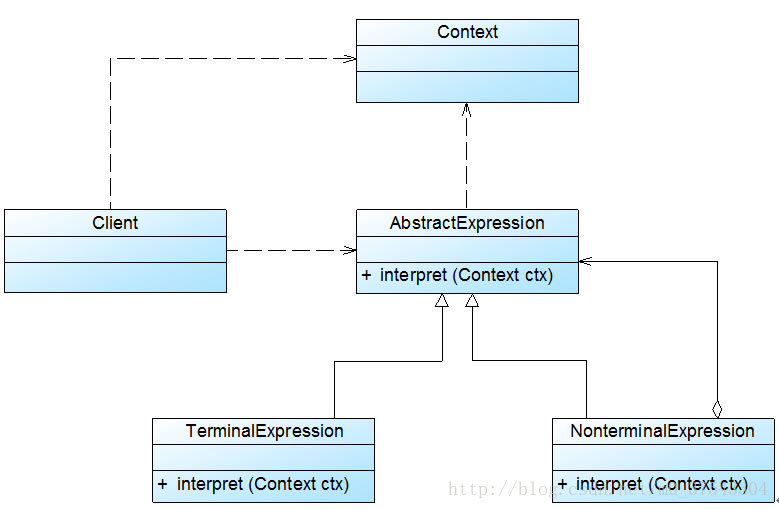转自:http://blog.csdn.net/lovelion/article/details/7713593
概述:解释器模式是一种使用频率相对较低但学习难度较大的设计模式,它用于描述如何使用面向对象语言构成一个简单的语言解释器。在某些情况下,为了更好地描述某一些特定类型的问题,我们可以创建一种新的语言,这种语言拥有自己的表达式和结构,即文法规则,这些问题的实例将对应为该语言中的句子。此时,可以使用解释器模式来设计这种新的语言。对解释器模式的学习能够加深我们对面向对象思想的理解,并且掌握编程语言中文法规则的解释过程。
角色:
- AbstractExpression(抽象表达式):在抽象表达式中声明了抽象的解释操作,它是所有终结符表达式和非终结符表达式的公共父类。
- TerminalExpression(终结符表达式):终结符表达式是抽象表达式的子类,它实现了与文法中的终结符相关联的解释操作,在句子中的每一个终结符都是该类的一个实例。通常在一个解释器模式中只有少数几个终结符表达式类,它们的实例可以通过非终结符表达式组成较为复杂的句子。
- NonterminalExpression(非终结符表达式):非终结符表达式也是抽象表达式的子类,它实现了文法中非终结符的解释操作,由于在非终结符表达式中可以包含终结符表达式,也可以继续包含非终结符表达式,因此其解释操作一般通过递归的方式来完成。
- Context(环境类):环境类又称为上下文类,它用于存储解释器之外的一些全局信息,通常它临时存储了需要解释的语句。
类图:
实现:
//注:本实例对机器人控制指令的输出结果进行模拟,将英文指令翻译为中文指令,实际情况是调用不同的控制程序进行机器人的控制,包括对移动方向、方式和距离的控制等
import java.util.*;
//抽象表达式
abstract class AbstractNode {
public abstract String interpret();
}
//And解释:非终结符表达式
class AndNode extends AbstractNode {
private AbstractNode left; //And的左表达式
private AbstractNode right; //And的右表达式
public AndNode(AbstractNode left, AbstractNode right) {
this.left = left;
this.right = right;
}
//And表达式解释操作
public String interpret() {
return left.interpret() + "再" + right.interpret();
}
}
//简单句子解释:非终结符表达式
class SentenceNode extends AbstractNode {
private AbstractNode direction;
private AbstractNode action;
private AbstractNode distance;
public SentenceNode(AbstractNode direction,AbstractNode action,AbstractNode distance) {
this.direction = direction;
this.action = action;
this.distance = distance;
}
//简单句子的解释操作
public String interpret() {
return direction.interpret() + action.interpret() + distance.interpret();
}
}
//方向解释:终结符表达式
class DirectionNode extends AbstractNode {
private String direction;
public DirectionNode(String direction) {
this.direction = direction;
}
//方向表达式的解释操作
public String interpret() {
if (direction.equalsIgnoreCase("up")) {
return "向上";
}
else if (direction.equalsIgnoreCase("down")) {
return "向下";
}
else if (direction.equalsIgnoreCase("left")) {
return "向左";
}
else if (direction.equalsIgnoreCase("right")) {
return "向右";
}
else {
return "无效指令";
}
}
}
//动作解释:终结符表达式
class ActionNode extends AbstractNode {
private String action;
public ActionNode(String action) {
this.action = action;
}
//动作(移动方式)表达式的解释操作
public String interpret() {
if (action.equalsIgnoreCase("move")) {
return "移动";
}
else if (action.equalsIgnoreCase("run")) {
return "快速移动";
}
else {
return "无效指令";
}
}
}
//距离解释:终结符表达式
class DistanceNode extends AbstractNode {
private String distance;
public DistanceNode(String distance) {
this.distance = distance;
}
//距离表达式的解释操作
public String interpret() {
return this.distance;
}
}
//指令处理类:工具类
class InstructionHandler {
private String instruction;
private AbstractNode node;
public void handle(String instruction) {
AbstractNode left = null, right = null;
AbstractNode direction = null, action = null, distance = null;
Stack stack = new Stack(); //声明一个栈对象用于存储抽象语法树
String[] words = instruction.split(" "); //以空格分隔指令字符串
for (int i = 0; i < words.length; i++) {
//本实例采用栈的方式来处理指令,如果遇到“and”,则将其后的三个单词作为三个终结符表达式连成一个简单句子SentenceNode作为“and”的右表达式,而将从栈顶弹出的表达式作为“and”的左表达式,最后将新的“and”表达式压入栈中。 if (words[i].equalsIgnoreCase("and")) {
left = (AbstractNode)stack.pop(); //弹出栈顶表达式作为左表达式
String word1= words[++i];
direction = new DirectionNode(word1);
String word2 = words[++i];
action = new ActionNode(word2);
String word3 = words[++i];
distance = new DistanceNode(word3);
right = new SentenceNode(direction,action,distance); //右表达式
stack.push(new AndNode(left,right)); //将新表达式压入栈中
}
//如果是从头开始进行解释,则将前三个单词组成一个简单句子SentenceNode并将该句子压入栈中
else {
String word1 = words[i];
direction = new DirectionNode(word1);
String word2 = words[++i];
action = new ActionNode(word2);
String word3 = words[++i];
distance = new DistanceNode(word3);
left = new SentenceNode(direction,action,distance);
stack.push(left); //将新表达式压入栈中
}
}
this.node = (AbstractNode)stack.pop(); //将全部表达式从栈中弹出
}
public String output() {
String result = node.interpret(); //解释表达式
return result;
}
} 工具类InstructionHandler用于对输入指令进行处理,将输入指令分割为字符串数组,将第1个、第2个和第3个单词组合成一个句子,并存入栈中;如果发现有单词“and”,则将“and”后的第1个、第2个和第3个单词组合成一个新的句子作为“and”的右表达式,并从栈中取出原先所存句子作为左表达式,然后组合成一个And节点存入栈中。依此类推,直到整个指令解析结束。
编写如下客户端测试代码:
class Client {
public static void main(String args[]) {
String instruction = "up move 5 and down run 10 and left move 5";
InstructionHandler handler = new InstructionHandler();
handler.handle(instruction);
String outString;
outString = handler.output();
System.out.println(outString);
}
} 





















 1387
1387

 被折叠的 条评论
为什么被折叠?
被折叠的 条评论
为什么被折叠?








